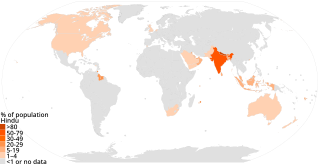
Religion is a range of social-cultural systems, including designated behaviors and practices, morals, beliefs, worldviews, texts, sanctified places, prophecies, ethics, or organizations, that generally relate humanity to supernatural, transcendental, and spiritual elements—although there is no scholarly consensus over what precisely constitutes a religion. Different religions may or may not contain various elements ranging from the divine, sacredness, faith, and a supernatural being or beings.
Irreligion is the absence or rejection of religious beliefs or practices. It encompasses a wide range of viewpoints drawn from various philosophical and intellectual perspectives, including atheism, agnosticism, religious skepticism, rationalism, secularism, and non-religious spirituality. These perspectives can vary, with individuals who identify as irreligious holding diverse beliefs about religion and its role in their lives.
Nontheism or non-theism is a range of both religious and non-religious attitudes characterized by the absence of espoused belief in the existence of God or gods. Nontheism has generally been used to describe apathy or silence towards the subject of gods and differs from atheism, or active disbelief in any gods. It has been used as an umbrella term for summarizing various distinct and even mutually exclusive positions, such as agnosticism, ignosticism, ietsism, skepticism, pantheism, pandeism, transtheism, atheism, and apatheism. It is in use in the fields of Christian apologetics and general liberal theology.

Hinduism has approximately 1.2 billion adherents worldwide. Hinduism is the third largest religion in the world behind Christianity (31.5%) and Islam (23.3%).

Hinduism is the largest religion of Nepal. In 2006, the country declared itself a secular country through democracy, after the abolition of its monarchy. According to the 2021 census, the Hindu population in Nepal is estimated to be around 23,677,744 which accounts for at least 81.19% of the country's population, the highest percentage of Hindus of any country in the world. Vikram Samvat, one of the two official calendars used in Nepal, is a solar calendar essentially the same to that widespread in North India as a religious calendar, and is based on solar units of time.
Cultural Muslims, also known as nominal Muslims, non-practicing Muslims or non-observing Muslims, are people who identify as Muslims but are not religious and do not practice the faith. They may be a non-observing, secular or irreligious individuals who still identify with Islam due to family backgrounds, personal experiences, ethnic and national heritage, or the social and cultural environment in which they grew up.

Religion has been a major influence on the societies, cultures, traditions, philosophies, artistic expressions and laws within present-day Europe. The largest religion in Europe is Christianity. However, irreligion and practical secularisation are also prominent in some countries. In Southeastern Europe, three countries have Muslim majorities, with Christianity being the second-largest religion in those countries. Ancient European religions included veneration for deities such as Zeus. Modern revival movements of these religions include Heathenism, Rodnovery, Romuva, Druidry, Wicca, and others. Smaller religions include Indian religions, Judaism, and some East Asian religions, which are found in their largest groups in Britain, France, and Kalmykia.
Accurate demographics of atheism are difficult to obtain since conceptions of atheism vary considerably across different cultures and languages, ranging from an active concept to being unimportant or not developed. Also in some countries and regions atheism carries a strong stigma, making it harder to count atheists in these countries. In global studies, the number of people without a religion is usually higher than the number of people without a belief in a deity and the number of people who agree with statements on lacking a belief in a deity is usually higher than the number of people who self-identify as "atheists".
Hindu atheism or non-theism, which is known as Nirīśvaravāda has been a historically propounded viewpoint in many of the Astika (Orthodox) streams of Hindu philosophy. Hindu spiritual atheists, agnostics or non-theists who affirm the sanctity of the Vedas and the concept of Brahman, as well as those who follow astika (orthodox) philosophies but reject personal god(s), are also called Dharmic atheists, Vedic atheists or Sanatani atheists.
Atheism, in the broadest sense, is an absence of belief in the existence of deities. Less broadly, atheism is a rejection of the belief that any deities exist. In an even narrower sense, atheism is specifically the position that there are no deities. Atheism is contrasted with theism, which is the belief that at least one deity exists.

Atheism, agnosticism, scepticism, freethought, secular humanism or general irreligion are increasing in Australia. Post-war Australia has become a highly secularised country. Religion does not play a major role in the lives of much of the population.
In the United States, between 4% and 15% of citizens demonstrated nonreligious attitudes and naturalistic worldviews, namely atheists or agnostics. The number of self-identified atheists and agnostics was around 4% each, while many persons formally affiliated with a religion are likewise non-believing.
Atheism and agnosticism have a long history in India and flourish within the Śramaṇa movement. Indian religions like Jainism, Hinduism and Buddhism consider atheism to be acceptable. Doubt has been ingrained even in Indian spiritual culture.
The relationship between the level of religiosity and the level of education has been studied since the second half of the 20th century.

Irreligion in Bulgaria pertains to atheism, agnosticism, and secularism among the citizens of Bulgaria. Irreligion is a minority religious position in Bulgaria. Making up approximately 5-10% of Bulgarians, irreligion is the second most common religious stance after Eastern Orthodoxy. Irreligion in Bulgaria is closely tied to the history of Marxism–Leninism and Soviet rule in the country during the 20th century.
Irreligion in Latin America refers to various types of irreligion, including atheism, agnosticism, deism, secular humanism, secularism and non-religious. According to a Pew Research Center survey from 2014, 8% of the population is not affiliated with a religion. According to Latinobarómetro, the share of irreligious people in Latin America quadrupled between 1996 and 2020, from 4% to 16%.

Irreligion in Turkey refers to the extent of the lack, rejection of, or indifference towards religion in the Republic of Turkey. Based on surveys, Islam is the predominant religion and irreligious people form a minority in Turkey. Precise estimates of the share of deists, atheists, agnostics, and other unaffiliated people in the population vary, though in survey averages they constitute a larger percentage than Christians and Jews in the country.

Irreligion in Croatia pertains to atheism, agnosticism, and lack of religious affiliation in Croatia. Even though the 2011 census showed that only 4.57% of Croats considered themselves irreligious, Gallup polls conducted in 2007 and 2008 found that 30.5% of respondents did not consider religion important in their lives. The Japanese research center, Dentsu, conducted a survey in 2006 concluding that 13.2% of Croats declare themselves irreligious, compared to the 7% found by a 2010 Eurobarometer survey across Europe.

Irreligion in Hungary pertains to atheism, agnosticism, and secularism in Hungary. The tradition of irreligion in Hungary originates from the time of Austria-Hungary and it was a significant part of Communist rule in the second half of the 20th century. As of 2011, irreligion is the country's second largest religious stance after Catholicism.







